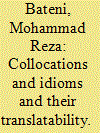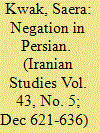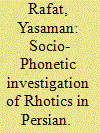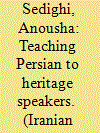| Srl | Item |
| 1 |
ID:
101020


|
|
|
|
|
| Publication |
2010.
|
| Summary/Abstract |
A collocation can be defined as a sequence of words which co-occur more than would be expected by chance. Collocations impose constraints on how words can be used together. An idiom is an expression whose meaning cannot be deduced from the literal definitions and the arrangement of its parts, but refers instead to a figurative meaning that is known only through common use. In this paper I will attempt to expand on these notions. For further clarification, I will compare and contrast some examples from English and Persian.
|
|
|
|
|
|
|
|
|
|
|
|
|
|
|
|
| 2 |
ID:
101023


|
|
|
|
|
| Publication |
2010.
|
| Summary/Abstract |
This paper classifies Persian negative elements and analyzes the negative structures based on Minimalism and Distributed Morphology. Negative Polarity Items (NPIs) in Persian which have [-neg] check its feature against [+neg] of negative marker for convergence. Negative Concord Items (NCIs), which are inherently negative, have [+neg]. Thus, in the NC Sentences, we have two [+neg]-one in negative marker, and the other in NCI. It can be misread that a NC structure, like Double Negation, delivers an affirmative reading. To prevent the misreading, we assumed Neg-absorption and Neg-criterion. However, that is impossible in Double Negation with two negative markers placed in different NegP, so the [+neg] in the sentence remain till Logical Form (LF) and they cancel each other and, as a result, the sentence becomes affirmative. Based on Minimalism and Distributed Morphology, the unified account on the structure of negation is examined.
|
|
|
|
|
|
|
|
|
|
|
|
|
|
|
|
| 3 |
ID:
101021


|
|
|
|
|
| Publication |
2010.
|
| Summary/Abstract |
The connection between proverbs and poetry is a profound and ancient one. The classical poets often cited well-known proverbs to attract and engage common people. In the case of legendary poets, some of their enchanting poems were well received and commonly repeated by ordinary people and gradually became famous proverbs themselves. More than any other Persian poets, Rumi, Saacutedi and Ferdowsi cited and created proverbs. Due to the condensed structure of maxims, often the preconditions and teachings of poets became distorted. As shown here, even the logical and philosophical views of Rumi and Khayyam were not spared. This is a common phenomenon in all languages, but can be reversed by finding their poetic roots and rediscovering the lost lessons of master poets. Nevertheless, the majority of proverbs are created by rural people to share, reason, and transfer their everyday life experiences to their children, one another and future generations.
|
|
|
|
|
|
|
|
|
|
|
|
|
|
|
|
| 4 |
ID:
101025


|
|
|
| 5 |
ID:
101024


|
|
|
|
|
| Publication |
2010.
|
| Summary/Abstract |
Although ezafe has been studied by many scholars for many years, it does not yet have a transparent grammatical status. Grammarians have regarded ezafe as a polysemous "word" carrying over ten different "meanings/functions." After a brief review of the previous treatments of ezafe, this paper will present a syntactic analysis, followed by a morphological description and a semantic analysis of this ubiquitous morpheme. It will also compare the distributional properties of other relevant bound morphemes with those of the ezafe. It will finally conclude that ezafe is a dummy clitic-like morpheme which is semantically void, while syntactically it functions as an "associative marker" which subordinates its [+N] host, on the left, to its following complements.
|
|
|
|
|
|
|
|
|
|
|
|
|
|
|
|
| 6 |
ID:
101026


|
|
|
|
|
| Publication |
2010.
|
| Summary/Abstract |
Although Persian language instruction has been facing demand outside Iran, little research has been conducted and few findings are available on teaching Persian to heritage speakers. This work studies teaching Persian language to students with a Persian background or second-generation Persians who have been raised outside Iran. I study the characteristics of heritage Persian speakers and describe their linguistics abilities and attitudes. Heritage learners are different from both foreign learners of Persian and native speakers of Persian. This article provides an underlying foundation for the research within the field of teaching Persian to heritage Persian speakers. Providing this general sketch will hopefully draw more attention to the promotion of a stronger educational system and more research on preserving and revitalizing Persian language amongst the new generation of Iranians living abroad.
|
|
|
|
|
|
|
|
|
|
|
|
|
|
|
|